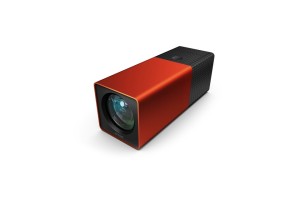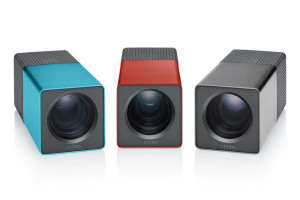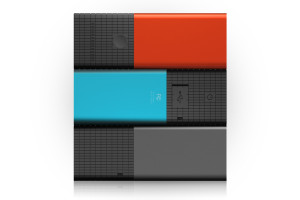The Social Media King of Cameras is here!
Lytro lets you take pictures like never before. Unlike a conventional camera that captures a single plane of light, the Lytro camera captures the entire light field, which is all the light traveling in every direction in every point in space.
Capture everything – instantly.
Capture living pictures with the press of a single button. By instantly capturing complete light field data, the Lytro camera gives you capabilities you’ve never had in a regular camera. Focus after the fact.
Capture everything – instantly.
Capture living pictures with the press of a single button. By instantly capturing complete light field data, the Lytro camera gives you capabilities you’ve never had in a regular camera. Focus after the fact.
 Since you’ll capture the color, intensity, and direction of all the light, you can experience the first major light field capability – focusing after the fact. Focus and re-focus, anywhere in the picture. You can refocus your pictures at anytime.
Since you’ll capture the color, intensity, and direction of all the light, you can experience the first major light field capability – focusing after the fact. Focus and re-focus, anywhere in the picture. You can refocus your pictures at anytime.
No auto-focus motor. No auto-focus motor means no shutter delay. So, capture the moment you meant to capture not the one a shutter-delayed camera captured for you. Share the love. #lytro#camera #photography
.
Easily share from the desktop or from Lytro.com to friends and family on Facebook, Twitter, email or your blog.
Lytro completes the job of taking light fields out of the research lab and making them available for everyone, in the form of the world’s first Lytro Light Field Camera.
.
Easily share from the desktop or from Lytro.com to friends and family on Facebook, Twitter, email or your blog.
Lytro completes the job of taking light fields out of the research lab and making them available for everyone, in the form of the world’s first Lytro Light Field Camera.
Defining the Light Field
The light field is a core concept in imaging science, representing fundamentally more powerful data than in regular photographs. The light field fully defines how a scene appears. It is the amount of light traveling in every direction through every point in space. Conventional cameras cannot record the light field.
Capturing the Light Field
Recording light fields requires an innovative, entirely new kind of sensor called a light field sensor. The light field sensor captures the color, intensity and vector direction of the rays of light. This directional information is completely lost with traditional camera sensors, which simply add up all the light rays and record them as a single amount of light.
Processing the Light Field
How do light field cameras make use of the additional information? By substituting powerful software for many of the internal parts of regular cameras, light field processing introduces new capabilities that were never before possible. Sophisticated algorithms use the full light field to unleash new ways to make and view pictures.
Relying on software rather than components can improve performance, from increased speed of picture taking to the potential for capturing better pictures in low light. It also creates new opportunities to innovate on camera lenses, controls and design.
The light field is a core concept in imaging science, representing fundamentally more powerful data than in regular photographs. The light field fully defines how a scene appears. It is the amount of light traveling in every direction through every point in space. Conventional cameras cannot record the light field.
Capturing the Light Field
Recording light fields requires an innovative, entirely new kind of sensor called a light field sensor. The light field sensor captures the color, intensity and vector direction of the rays of light. This directional information is completely lost with traditional camera sensors, which simply add up all the light rays and record them as a single amount of light.
Processing the Light Field
How do light field cameras make use of the additional information? By substituting powerful software for many of the internal parts of regular cameras, light field processing introduces new capabilities that were never before possible. Sophisticated algorithms use the full light field to unleash new ways to make and view pictures.
Relying on software rather than components can improve performance, from increased speed of picture taking to the potential for capturing better pictures in low light. It also creates new opportunities to innovate on camera lenses, controls and design.
About Living Pictures
The way we communicate visually is evolving rapidly, and people’s expectations are changing in lockstep. Light field cameras offer astonishing capabilities. They allow both the picture taker and the viewer to focus pictures after they’re snapped, shift their perspective of the scene, and even switch seamlessly between 2D and 3D views. With these amazing capabilities, pictures become immersive, interactive visual stories that were never before possible – they become living pictures.
To create a shot like that, you’ll need to use Creative Mode. This is about as “pro” as the Lytro gets, and it’s pretty simple. What Creative Mode does is change the center of focus — essentially the “default” distance that the camera uses as a reference for your refocusing range. In regular mode, the minimum distance (where things start to go blurry no matter what) is about 6 inches. In Creative Mode, it’s wherever you want; just tap your target on the screen, and the center-of-focus zeros in on that subject.
The way we communicate visually is evolving rapidly, and people’s expectations are changing in lockstep. Light field cameras offer astonishing capabilities. They allow both the picture taker and the viewer to focus pictures after they’re snapped, shift their perspective of the scene, and even switch seamlessly between 2D and 3D views. With these amazing capabilities, pictures become immersive, interactive visual stories that were never before possible – they become living pictures.
Getting Great Lytro Photos
This is not a camera for pros or science nerds. This is primarily a camera for casual photographers — people who probably take most of their pictures on a cellphone or a Flip camera. It’s simple to use, and the photos are clearly crafted for sharing.
You’ll get photos with the most dramatic refocusing effects if you do three simple things:
- Get up close and personal with your subject. Don’t be afraid to jam the Lytro right in the face of the person (or whatever) that you want in the foreground. Indeed, if you don’t do this the focus effect, while present, won’t be that pronounced. You may need to use the Lytro’s Creative Mode to help you if you’re really close (more on that in a bit).
- Zoom. A lot. Zooming in will emphasize the difference in focus between subjects even more. Of course, it may also push some things out of the frame, so use carefully.
- Have a “distant” background. To get the maximum blur/focus effect on your foreground subject, try to have something in the background that’s very far away. If you’re outside, this should be easy, but indoors it helps to either shoot in front of a window (with distant objects outside) or frame your shot with a wall as far back as possible.

To create a shot like that, you’ll need to use Creative Mode. This is about as “pro” as the Lytro gets, and it’s pretty simple. What Creative Mode does is change the center of focus — essentially the “default” distance that the camera uses as a reference for your refocusing range. In regular mode, the minimum distance (where things start to go blurry no matter what) is about 6 inches. In Creative Mode, it’s wherever you want; just tap your target on the screen, and the center-of-focus zeros in on that subject.
Sharing and Software
The “light field engine” on board the Lytro does the heavy lifting in making a photo you can refocus. It then creates a self-contained file — an “.lfp” file — that you transfer to your Mac. PC software is in process.
You can also share Lytro living pictures on the world’s biggest photo-sharing site: Facebook. You can share either from your account on Lytro.com or straight from they Lytro client software. When someone first clicks on the photo, the pic politely tells the person that that they can click to refocus and double click to zoom.
The Lytro experience is all about sharing.
The aspect ratio is locked, so forget changing it. In fact there’s no editing software of any kind; no adjusting, cropping or even touching up your photos. What you’ve captured is what you’ve got, at least for now — Lytro says editing software is in the works.
Clicking on the Info button while viewing a photo in the client or on Lytro.com reveals the date, shutter speed, ISO, focal length and whether or not the picture was taken in Creative Mode. You generally don’t get that level of information with most cameras — one of the benefits of the image format coming from the same company that makes your hardware.
An annoying detail: The magnetic lens cap seems almost designed so you’ll lose it. The magnet holds it pretty loosely, and it has a propensity to slide off. I know Lytro’s trying to stand out with its design, but a regular cap that snaps in place would have been a much better choice.
Camera phones have been getting people to think less about focus and more about sharing for years. While the choice to target only Mac users right out of the gate is a bit perplexing, emphasizing sharing via Facebook is an excellent, if not essential move.
The social aspect is where Lytro lives or dies. If its early adopters start telling stories with their cameras — and those stories are worth sharing — Lytro will transition from curious trick to phenomenon. Very Promising Technology!
Price and Appeal
The appeal is easy to see—everyone who has picked up a camera has had to deal with missing a crucial shot due to a focus error. It’s available in two versions—a $399 model with 8GB of internal memory, and a $499 version with 16GB.
Our company will blast your brand into the next level.
We represent multiple major corporations and they are available for references. [email protected]
www.ownsocialmedia.com
www.monopolizesocialmedia.com
https://www.facebook.com/MonopolizeSocialMedia
https://plus.google.com/u/0/+JustinMatthewSocialMedia/posts
https://plus.google.com/u/0/+Monopolizesocialmedia/posts
We represent multiple major corporations and they are available for references. [email protected]
www.ownsocialmedia.com
www.monopolizesocialmedia.com
https://www.facebook.com/MonopolizeSocialMedia
https://plus.google.com/u/0/+JustinMatthewSocialMedia/posts
https://plus.google.com/u/0/+Monopolizesocialmedia/posts
























